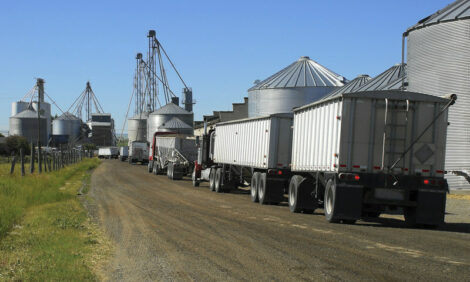



Viet Nam: Hog Markets
VIET NAM - Ron Lane, Business Director for Asia Pacific and Meggie Vo, Genesus Representative, provide the latest update on the hog market in Viet Nam.- According to a survey by the General Statistics Office, the country had 26.3 million pigs on farm at the end of December, 2013 (a decrease of 0.9 per cent compared to the same period last year). There is estimated to be 3.9 million sows (a decrease of 2 per cent compared with the same period last year) in the total country.
- For the entire year, the total meat supply is estimated to be at 4.3 million tonnes, an increase of 1.49 per cent compared with 2012. In 2013, pork supply reached 3.2 million tonnes (up 1.8 per cent); poultry meat production reached 746.9 thousand tonnes (sales rose 2.4 per cent- up slightly); buffalo meat reached 85.3 thousand tons (down 3.5 per cent); and beef reached 285.4 thousand tons (down 2.9 per cent) compared with 2012.
- Pork supply still represents about 74.4 per cent of the total meat supply in Viet Nam.
- During most of 2013, the market prices of the various livestock have shown a large variation and thus profitability/losses. Market pig prices declined sharply and until the middle months of 2013 around 38,000 to 39,000VND/kg ($1.80US/kg-$0.82US/lb. to $1.85US/kg-$0.84US/lb.), but since that time, the price has risen until it reached 55,000VND/kg ($2.61US/kg-$1.18US/lb.) as a high in December 2013. Poultry on the other hand has had a reverse market price as compared to pigs. This is mainly due to the fear of bird flu and thus a big switch from poultry to pork. At the beginning of 2013, poultry was 48,000 VND/kg ($2.28US/kg - $1.03US/lb.), but at the end of 2013, the price was down to 23,000 to 24,000VND/kg ($1.09US/kg-$0.50US/lb. to $1.14US/kg - $0.52US/lb.). At this price, poultry producers would lose VND 10,000-12,000 VND/kg ($0.47US/kg - $0.22US/lb. to $0.57US/kg-$0.26US/lb.) per bird (the price of chicken has increased by 26 per cent since last month to a level of 37,000 to 38,000 VND/kg ($1.76US/kg - $0.80US/lb. to $1.80US/kg - per cent0.82US/lb.).
- Last week and in recent discussion with producers in Dong Nai province, market pig prices were about 49,000 to 52,000 VND/kg ($2.32US-1.05US/lb. to $2.37US/kg - $1.08US/lb.) and cost of production was about 40,000 to 42,000 VND/kg ($1.90US/kg-$0.86US/lb. to $1.99US/kg - $0.90US/lb.). Profit was 8,000-10,000 VND/kg ($0.38US/kg - $0.17US/lb. to $0.47US/kg - $0.22US/lb.) or about $37.95 to $47.44US/market pig. However, the market price has been lower in the Hanoi region at 43,000VND/kg ($2.04US/kg - $0.93US/lb.). Some pigs from the Hanoi region have been moving towards Ho Chi Minh market with the favourable market prices. China has basically stopped buying live pigs from Viet Nam, as the prices in China are quite low now.
- The Ministry of Agriculture and Rural Development (MARD) explains that a growing demand and growth in the local livestock industry is driving the surge in the imports of grains. During the first 2 months of 2014, Viet Nam imported about 375 million USD in feed and ingredients, up 4.7 per cent compared to the same period in 2013. This included 1.26 million tonnes of corn-increasing 7 folds in volume year on year. The main suppliers are:
Argentina (30.8 per cent), America (15.3 per cent) and India (10.9 per cent). - Currently corn is 6,615 VND/kg-$0.31US/kg-$0.14US/lb.), up 1.6 per cent; soybean meal is14, 750 VND/kg ($0.70/kg-$0.32US/lb.), up 1.4 per cent; rice bran is7, 245 VND/kg ($0.34US/kg-$0.16US/lb.), up 1.5 per cent and cassava is 5,355 VND/kg ($0.25US/kg-$0.12US/lb.), up 2 per cent. All prices are compared to last month. Complete finisher pig feed from 60 to market weight is 10,489/kg ($0.50US/kg-$0.23US/lb.).
- In 2013, Viet Nam imported 1.39 million tonnes of soybeans (value of $834 million USD); 2.26 million tonnes of corn (value of $690 million USD) and 1.71 million tonnes of wheat (value of $584 million USD). The Ministry of Industry and Trade predicts a growth rate in the feed business of 20 per cent per year for the next two years.
- At the GIRA Asia Meat Club, Robert Claxton, reported that in Viet Nam, the domestic demand for pork is still strong and that great gains have been made in the transition from backyard farming to commercial farm operations. Currently, there is little integration between the producers and the slaughter houses. There is a vast potential to supply pork to the south of China (as was shown recently this fall); whereas, an adequate domestic supply of pork limits the import opportunities. As reported, consumers still prefer warm (wet market) meat rather than the chilled meat. This is still mainly due to the Country’s limited cold chain system. However, the modern retail outlets in particular in the south are gaining market share.
- CP Viet Nam manufactures the most feed in the Country. The 5 animal feed mills and the 3 fish feed mills, with a capacity of 3.8 million tonnes of feed per year, holds 19 per cent of the market share. Proconco, with 1.25 million tonnes of animal feed produced in 2013, is the second largest feed miller and has a market share of 11 per cent.
- General Statistics Office has released the consumer price index (CPI) for February and it increased by 0.55 per cent from the previous month. February CPI increased by 4.65 per cent since February, 2013, the lowest increase in the past 10 years. Since January 1st, the CPI has increased by 1.24 per cent. Food and food services were the main factors to increase CPI.
- Data from MOA suggests the total value of imported feeds and raw ingredients reached a total of $ 3 billion USD for 2013.This is a 22.3 per cent increase in total value from the 2012 imports. Most of this increase is due to the higher costs associated with droughts in 2012 and thus the higher costs for all feed ingredients.
- Information from the Government, indicates that about 30 per cent of the domestic market supplies the animal feed industry; whereas, the foreign suppliers contribute the majority or 70 per cent of the total share. MOA has reported that they would like to convert this year about 130,000 hectares of rice land to grow both corn and cassava-mainly for animal feed production. This will increase the corn production area by 73,000 hectares to give a 1.23 million hectares base as compared to 2013. Also, by using high yielding varieties of corn, the expected yield would increase to 5.7 million tonnes of corn for 2014. Cassava production will aim for 10 million tonnes on a total of 550,000 hectares of land base.
- Currently, the number of swine in Viet Nam is estimated to decrease compared with the same period in 2013. Some of this is related to persistence disease affects from PRRS, FMD and piglet fevers. Recent profit losses along with the shortage of available funds and credit for the farmers from the banks are also factors to deter growth in the pig production business.
| Genesus Global Market Report Prices for the week of 24 February 2014 | ||
|---|---|---|
| Country | Domestic price (own currency) | US dollars (Liveweight a lb) |
| USA (Iowa-Minnesota) | 126.64 USD/lb carcass | 93.71¢ |
| Canada (Ontario) | 237.51 CAD/kg carcass | 77.23¢ |
| Mexico (DF) | 28.13 MXN/kg liveweight | 97.20¢ |
| Brazil (South Region) | 3.51 BRL/kg liveweight | 68.93¢ |
| Russia | 84 RUB/kg liveweight | $1.07 |
| China | 10.81 RMB/kg liveweight | 78.98¢ |
| Spain | 1.25 EUR/kg liveweight | 78.22¢ |
| Viet Nam | 50,000 VND/kg liveweight | $1.08 |
| South Korea | 4,339 KRW/kg liveweight | $1.83 |









